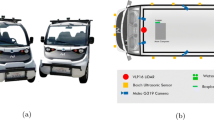Abstract
In this paper, we present a system level approach to smart wheelchair system (SWS) navigation in urban environments. The proposed SWS ecosystem has two primary components: a mapping service which generates large-scale landmark maps, and the SWS vehicle itself, which is a client of the mapping service. The SWS prototype integrates 3D LIDAR/imaging systems which provide robust perception in unstructured, outdoor environments. It also leverages these same sensors for map-based localization. In demonstrating the efficacy of the approach, the SWS navigated autonomously over a distance of more than 12 km in a representative urban environment without once losing localization, and without the use of GPS.



















Similar content being viewed by others
References
Anguelov, D., Dulong, C., Filip, D., Frueh, C., Lafon, S., Lyon, R., et al. (2010). Google street view: Capturing the world at street level. Computer, 6, 32–38.
Baldwin, I., & Newman, P. (2012). Road vehicle localization with 2d push-broom lidar and 3d priors. In IEEE International Conference on Robotics and Automation (ICRA) (pp. 2611–2617).
Bohren, J., Foote, T., Keller, J., Kushleyev, A., Lee, D., Stewart, A., et al. (2008). Little ben: The ben franklin racing team’s entry in the 2007 DARPA urban challenge. Journal of Field Robotics, 25(9), 598–614.
Bostelman, R., & Albus, J. (2008). Sensor experiments to facilitate robot use in assistive environments. In Proceedings of the 1st international conference on PErvasive Technologies Related to Assistive Environments (p. 8) ACM
Chong, Z., Qin, B., Bandyopadhyay, T., Ang, M.H., Frazzoli, E., & Rus, D. (2013). Synthetic 2d lidar for precise vehicle localization in 3d urban environment. In IEEE International Conference on Robotics and Automation (ICRA) (pp. 1554–1559).
Cooper, R., Grindle, G., Vazquez, J., Xu, J., Wang, H., Candiotti, J., et al. (2012). Personal mobility and manipulation appliance design, development, and initial testing. Proceedings of the IEEE, 100(8), 2505–2511.
Doshi, F., & Roy, N. (2007). Efficient model learning for dialog management. In: 2nd ACM/IEEE International Conference on Human-Robot Interaction (HRI), 2007 (pp. 65–72).
Fischler, M. A., & Bolles, R. C. (1981). Random sample consensus: A paradigm for model fitting with applications to image analysis and automated cartography. Communications of the ACM, 24(6), 381–395.
Gao, C., Hoffman, I., Panzarella, T., & Spletzer, J. (2007). Automated transport and retrieval system (atrs): A technology solution to automobility for wheelchair users. In 6th Conference on Field and Service Robotics (FSR07)
Gao, C., Miller, T., Spletzer, J. R., Hoffman, I., & Panzarella, T. (2008). Autonomous docking of a smart wheelchair for the automated transport and retrieval system (ATRS). Journal of Field Robotics, 25(4–5), 203–222.
Gao, C., Sands, M., & Spletzer, J.R. (2010). Towards autonomous wheelchair systems in urban environments. In Field and Service Robotics (pp. 13–23). Springer
Irie, K., & Tomono, M. (2012). Localization and road boundary recognition in urban environments using digital street maps. In IEEE International Conference on Robotics and Automation (ICRA) (pp. 4493–4499).
Kummerle, R., Ruhnke, M., Steder, B., Stachniss, C., & Burgard, W. (2013). A navigation system for robots operating in crowded urban environments. In IEEE International Conference on Robotics and Automation (ICRA), 2013 (pp. 3225–3232)
Lategahn, H., Schreiber, M., Ziegler, J., & Stiller, C. (2013). Urban localization with camera and inertial measurement unit. In IEEE Intelligent Vehicles Symposium (IV) (pp. 719–724).
LaValle, S. M. (2006). Planning algorithms. Cambridge: Cambridge University Press.
Montella, C., Perkins, T., Spletzer, J., & Sands, M. (2014). To the bookstore! autonomous wheelchair navigation in an urban environment. In Field and Service Robotics (pp. 249–263). Springer
Montella, C., Pollock, M., Schwesinger, D., & Spletzer, J.R. (2012). Stochastic classification of urban terrain for smart wheelchair navigation. In Proceedings of the IROS Workshop on Progress, Challenges and Future Perspectives in Navigation and Manipulation Assistance for Robotic Wheelchairs
Montemerlo, M., & Thrun, S. (2007). Fastslam 2.0. FastSLAM: A scalable method for the simultaneous localization and mapping problem in robotics (pp. 63–90). Berlin: Springer.
Perry, D. (2002). Medical never-never land: Ten reasons why america is not ready for the coming age boom (p. 1). Washington, DC: Alliance for Aging Research.
Quigley, M., Conley, K., Gerkey, B., Faust, J., Foote, T., Leibs, J., Wheeler, R., & Ng, A.Y. (2009). Ros: an open-source robot operating system. In ICRA workshop on open source software, vol. 3 (p. 5)
Rusu, R.B., & Cousins, S. (2011). 3d is here: Point cloud library (pcl). In IEEE International Conference on Robotics and Automation (ICRA) (pp. 1–4).
Simonite, T. (2013). Data shows Googles robot cars are smoother, safer drivers than you or I. In Technology Review, Vol. 25.
Simpson, R. C. (2005). Smart wheelchairs: A literature review. Journal of Rehabilitation Research and Development, 42(4), 423.
Thrun, S., Burgard, W., & Fox, D. (2005). Probabilistic robotics. Cambridge: MIT press.
United Nations Department of Economic and Social Affairs: World Urbanization Prospects: The 2014 Revision. United Nations Publications (2015).
Yokozuka, M., Suzuki, Y., Hashimoto, N., Matsumoto, O.: Robotic wheelchair with autonomous traveling capability for transportation assistance in an urban environment. In IEEE/RSJ International Conference on Intelligent Robots and Systems (IROS) (pp. 2234–2241).
Author information
Authors and Affiliations
Corresponding author
Additional information
This is one of several papers published in Autonomous Robots comprising the “Special Issue on Assistive and Rehabilitation Robotics”.
Rights and permissions
About this article
Cite this article
Schwesinger, D., Shariati, A., Montella, C. et al. A smart wheelchair ecosystem for autonomous navigation in urban environments. Auton Robot 41, 519–538 (2017). https://doi.org/10.1007/s10514-016-9549-1
Received:
Accepted:
Published:
Issue Date:
DOI: https://doi.org/10.1007/s10514-016-9549-1




